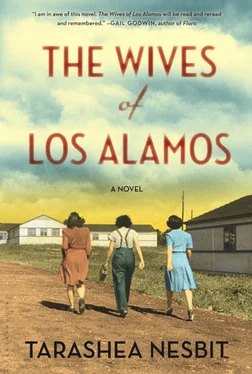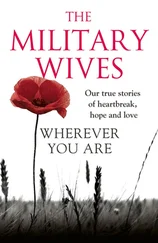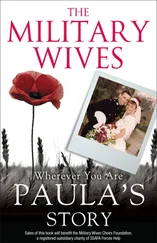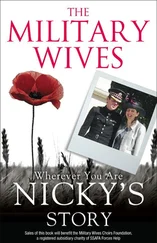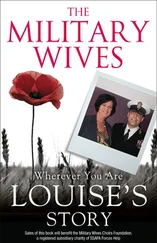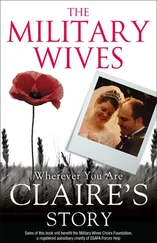WE PONDERED WHAT it would be like to be our daughters, to be living as a woman in another generation, and we felt a bit jealous. We thought our daughters had many more freedoms than we did in choosing a career—they did not have to be schoolteachers or secretaries—in traveling alone—they could just pick up and move across the country—in taking oneself to a movie in the middle of a Sunday afternoon. Or we could see how so many options might render decisions more difficult to make. And when they said, The only way to improve the world is to protest war , we thought them unreasonably idealistic, or we thought them more of what the world needed.
OUR CHILDREN SAID they would go to jail rather than be drafted. And some of us worried we had spoiled them somehow. Our children said they did not tell their friends what their fathers did because their fathers worked for the man , but we thought that keeping quiet about Los Alamos and the violence or triumph of what our husbands did was not because they felt a sense of responsibility to a collective; rather, they felt the shame of the individual: they were worried about their own reputations. Or all that secret keeping had deeply affected them. The outside world seemed very nosy.
PERHAPS SOME OF our children did care about their country in the ways some of us understood, and they volunteered for the Vietnam War rather than protesting it, and they came back changed, as we knew they would, though the particulars of those changes were mysterious. Edward was much more tidy and pensive after his return, and married Anne, who worked as a cashier at Dot’s Market and brought us embroidered napkins. They went on to have four children, and experience the shifts and swings of marriages, but nothing too serious. David appeared more cynical, went back to school to study philosophy, and called himself a poet. Tim moved back in with us, nailed quilts to his bedroom wall to cover the windows, slept during the day, and woke with nightmares. Bobby married, though his wife appeared more and more tired over the years, and he brought a twelve-pack to every family gathering, even Sunday brunch, and we sensed something was not right, but any interference was met with anger. Our children carried concealed weapons, had gun collections, refused to sit with their backs to any window. Or they came home from Vietnam and they were quiet about their time there and we could not tell what effect the war had on them at all, except they seemed more grateful for our macaroni loaf.
THEY HAD KNOWN war differently than us and our husbands. They had seen death more immediately: the eyes of people whom we called our enemy.
SOME OF US did not mind that our children no longer went to church or synagogue, some of us thought the fact that our children were gay might make life complicated, or maybe not, and we accepted that our children supported abortion rights. When they brought home brownies they were the best brownies we had ever tasted and after two brownies we felt the tickling of the wind on our cheeks and we just wanted to watch the clouds pass overhead and tell our children how much we loved and admired them. We felt very calm, perhaps even happy.
OUR CHILDREN GREW up; they became engineers, peace activists, grade school teachers, housewives, photographers, writers, bums. They became landscape painters, vice presidents of banks, psychologists; they became the children we outlived; they became the children who died of lung cancer; they became botanists, directors of physics labs, park rangers, geologists, lawyers, and environmental activists.
THEY FINISHED COLLEGE and did not see any reason to rush into getting a job or marrying and instead they sold all of their possessions and joined what they called a commune and what we called a cult.
OUR CHILDREN CLAIMED to be conscientious objectors, they said they were going to bum around Europe with their girlfriends and boyfriends after college, and we objected, You are ruining your life! Or we thought they would not actually do it, so we just raised an eyebrow, but they did just that, they went.
AND THEY WERE young and we thought they would grow out of it. Or we could see their point, but we did not know of alternatives, or we joined our children in protests. Or to really protest the war our children thought they needed to know more about history and so instead of sit-ins they went to graduate school. Some dropped out, got married, and went back to study biology. And no one was hiring in biology, but Los Alamos was hiring scientists for their computer skills, and we knew people, and our husbands knew people, and so our children moved back to Los Alamos and worked at the lab their fathers worked at, partly, they said, so their own three children could live as close to nature as they had, or to live close to us, their grandparents.
OUR CHILDREN DID not directly work on bombs, but they built computer programs to assist with bomb making, and they said they felt conflicted, and they said, If I had a perfect freedom of choice I wouldn’t do it , and they said, I just have to put up with some stuff I’m not comfortable with in order to give my kids a good home , and they said, I have to sacrifice some of my conscience for some other benefits .
THEY SAID THEY didn’t really appreciate what their fathers did until they returned to the Lab to work there themselves. They said their work was of a secret nature but if atomic weapons were used on a new war over oil they would quit their jobs at Los Alamos, they really would.
OR OUR CHILDREN went to the Marshall Islands as Peace Corps members because though the Marshallese had been evacuated from Bikini Island, they were moved to nearby islands, close enough to atomic testing to birth dead babies, or living babies that they called jellyfish babies for their half-formed limbs. Scientists wondered, What are the effects of nuclear fallout on pregnant women and their fetuses? Now there was evidence. Our children saw that a curtain had been drawn back.
OUR CHILDREN RETURNED to New Mexico as they always thought they would and we went back to visit them. We went back and we saw a fast food restaurant erected where a lab once was. The guard gate was taken down. We saw many more concrete block lab buildings painted white.
WHILE OUR CHILDREN were at work we made tea in their sky-lighted houses, fetched the paper from the front steps, and read the New Mexican Reporter with interest. Some residents claimed there was a significant increase in brain cancer in one particular neighborhood close to the canyon, a beloved canyon of ours now disgraced with the nickname Acid Canyon, and some of us thought that was where materials had been dumped, and we did not know what to make of it. We heard that the golf course we had made was given a nice facelift, and that the social groups we started had grown by the hundreds, and we were delighted to be asked for an interview by the Los Alamos Historical Society. On a Friday afternoon we took the public bus, Atomic City Transit, to that lodge we slept in the first day we arrived at Los Alamos in 1943.
ON OUR BUS ride we passed the visitor center, which was in a strip mall, and we stopped at the science museum. We read about the fused sand, the proliferation of honey pot ants as natural miners of the area; we saw photos of the female scientists enlarged and framed on the walls, images of these women then, during the war years, and now, on their front porches, without their husbands. For goodness’ sake , we said, to no one in particular.
DURING OUR INTERVIEW we were asked, What was it like? And we answered questions about what it was like then, and we felt a mix of emotions recalling that time: sadness for what was now in the past, but happiness about the recollection. We were pleased to visit the two museums in town and read our own family stories on the walls, to see a copy of a letter we wrote our mother in 1944, how Bobby was doing fine, how we really needed long johns. Inside one museum we saw Nancy’s birth certificate framed with the birth location listed as Post Office Box 1663. And we thought of what was in the letter that we did not say, how we made our voices sound lighter than we felt when writing to our mothers.
Читать дальше
